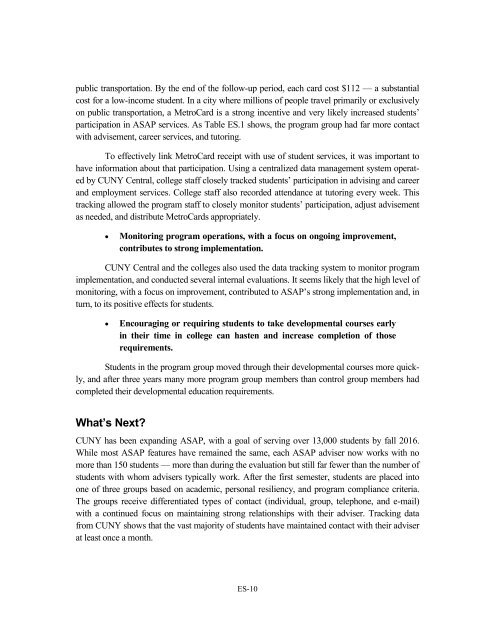1dOprzL
1dOprzL
1dOprzL
You also want an ePaper? Increase the reach of your titles
YUMPU automatically turns print PDFs into web optimized ePapers that Google loves.
public transportation. By the end of the follow-up period, each card cost $112 — a substantialcost for a low-income student. In a city where millions of people travel primarily or exclusivelyon public transportation, a MetroCard is a strong incentive and very likely increased students’participation in ASAP services. As Table ES.1 shows, the program group had far more contactwith advisement, career services, and tutoring.To effectively link MetroCard receipt with use of student services, it was important tohave information about that participation. Using a centralized data management system operatedby CUNY Central, college staff closely tracked students’ participation in advising and careerand employment services. College staff also recorded attendance at tutoring every week. Thistracking allowed the program staff to closely monitor students’ participation, adjust advisementas needed, and distribute MetroCards appropriately.• Monitoring program operations, with a focus on ongoing improvement,contributes to strong implementation.CUNY Central and the colleges also used the data tracking system to monitor programimplementation, and conducted several internal evaluations. It seems likely that the high level ofmonitoring, with a focus on improvement, contributed to ASAP’s strong implementation and, inturn, to its positive effects for students.• Encouraging or requiring students to take developmental courses earlyin their time in college can hasten and increase completion of thoserequirements.Students in the program group moved through their developmental courses more quickly,and after three years many more program group members than control group members hadcompleted their developmental education requirements.What’s Next?CUNY has been expanding ASAP, with a goal of serving over 13,000 students by fall 2016.While most ASAP features have remained the same, each ASAP adviser now works with nomore than 150 students — more than during the evaluation but still far fewer than the number ofstudents with whom advisers typically work. After the first semester, students are placed intoone of three groups based on academic, personal resiliency, and program compliance criteria.The groups receive differentiated types of contact (individual, group, telephone, and e-mail)with a continued focus on maintaining strong relationships with their adviser. Tracking datafrom CUNY shows that the vast majority of students have maintained contact with their adviserat least once a month.ES-10


